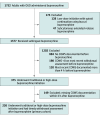Buprenorphine-Precipitated Withdrawal Among Hospitalized Patients Using Fentanyl
- PMID: 39331392
- PMCID: PMC11437388
- DOI: 10.1001/jamanetworkopen.2024.35895
Buprenorphine-Precipitated Withdrawal Among Hospitalized Patients Using Fentanyl
Abstract
Importance: Buprenorphine treatment of opioid use disorder (OUD) is safe and effective, but opioid withdrawal during treatment initiation is associated with poor retention in care. As fentanyl has replaced heroin in the drug supply, case reports and surveys have indicated increased concern for buprenorphine-precipitated withdrawal (PW); however, some observational studies have found a low incidence of PW.
Objective: To estimate buprenorphine PW incidence and assess factors associated with PW among emergency department (ED) or hospitalized patients.
Design, setting, and participants: This retrospective cohort study at 3 academic hospitals in Philadelphia, Pennsylvania, included adults with OUD who underwent traditional or high-dose buprenorphine initiation between January 1, 2020, and December 31, 2021. Exclusion criteria included low-dose buprenorphine initiation and missing documentation of opioid withdrawal severity within 4 hours of receiving buprenorphine.
Exposure: Buprenorphine initiation with an initial dose of at least 2 mg of sublingual buprenorphine after a Clinical Opiate Withdrawal Scale (COWS) score of 8 or higher. Additional exposures included 4 predefined factors potentially associated with PW: severity of opioid withdrawal before buprenorphine (COWS score of 8-12 vs ≥13), initial buprenorphine dose (2 vs 4 or ≥8 mg), body mass index (BMI) (<25 vs 25 to <30 or ≥30; calculated as weight in kilograms divided by height in meters squared), and urine fentanyl concentration (0 to <20 vs 20 to <200 or ≥200 ng/mL).
Main outcome and measures: The main outcome was PW incidence, defined as a 5-point or greater increase in COWS score from immediately before to within 4 hours after buprenorphine initiation. Logistic regression was used to estimate the odds of PW associated with the 4 aforementioned predefined factors.
Results: The cohort included 226 patients (150 [66.4%] male; mean [SD] age, 38.6 [10.8] years). Overall, 26 patients (11.5%) met criteria for PW. Among patients with PW, median change in COWS score was 9 points (IQR, 6-13 points). Of 123 patients with confirmed fentanyl use, 20 (16.3%) had PW. In unadjusted and adjusted models, BMI of 30 or greater compared with less than 25 (adjusted odds ratio [AOR], 5.12; 95% CI, 1.31-19.92) and urine fentanyl concentration of 200 ng/mL or greater compared with less than 20 ng/mL (AOR, 8.37; 95% CI, 1.60-43.89) were associated with PW.
Conclusions and relevance: In this retrospective cohort study, 11.5% of patients developed PW after buprenorphine initiation in ED or hospital settings. Future studies should confirm the rate of PW and assess whether bioaccumulated fentanyl is a risk factor for PW.
Conflict of interest statement
Figures
Comment in
-
Precipitated Withdrawal in the Era of Street Fentanyl-The Important Thing Is to Not Stop Questioning.JAMA Netw Open. 2024 Sep 3;7(9):e2435857. doi: 10.1001/jamanetworkopen.2024.35857. JAMA Netw Open. 2024. PMID: 39331399 No abstract available.
References
-
- American Society of Addiction Medicine . The ASAM National Practice Guideline for the Treatment of Opioid Use Disorder: 2020 focused update. J Addict Med. 2020;14(2S)(suppl 1):1-91. - PubMed
-
- Leshner AI, Mancher M, eds. Medications for Opioid Use Disorder Save Lives: A Consensus Study Report of the National Academies of Sciences, Engineering, and Medicine. National Academies Press; 2019. - PubMed
-
- Johnson RE, Strain EC, Amass L. Buprenorphine: how to use it right. Drug Alcohol Depend. 2003;70(2)(suppl):S59-S77. - PubMed
Publication types
MeSH terms
Substances
Grants and funding
LinkOut - more resources
Full Text Sources
Medical
Research Materials
Miscellaneous


